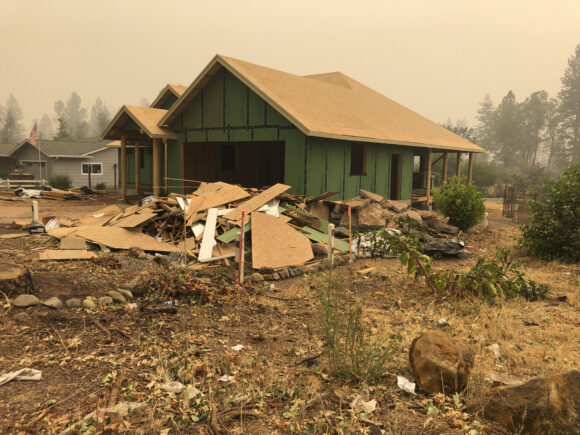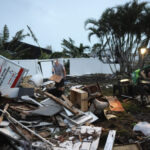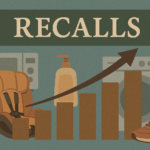SAN FRANCISCO (AP) — California state and local officials are encouraging rebuilding in areas destroyed by wildfires at a time when people should be redirected away from those areas if the state wants to reduce the economic and human impact of increasingly destructive wildfires, according to a report published Thursday.
State and local policies emphasize retrofitting existing homes and ensuring homes have defensible space and communities have evacuation plans. This encourages wildfire victims to rebuild in fire-prone areas, found a study by the University of California, Berkeley Center for Community Innovation that was commissioned by Next 10, a nonpartisan think tank.
The researchers studied the recovery efforts after the 2017 Tubbs Fire in Santa Rosa, the 2017 Thomas Fire in Ventura and the 2018 Camp Fire in Paradise. They concluded that those massive and fatal wildfires highlight the urgency for policymakers to push for policies that make it easier to build housing in urban areas and promote the conservation of land, the researchers said.
The researchers said the state should offer a tax incentive to people who lose homes in a wildfire, to encourage them to move to lower-risk areas. Officials should also make it hard for developers to build in the wildland-urban interface, they said.
The time to act is right after a devastating wildfire when people are trying to make decisions about whether to rebuild or relocate, said Robert Olshansky, one of the report’s lead authors and professor emeritus at the University of Illinois, Urbana-Champaign.
“The state is talking about more restrictions on building new homes in the wildland areas. But it’s very hard to deal with the existing homes,” Olshansky said. “One time when you can actually deal with this is once a fire occurs.”
A proposal that would require developers to build in the least-risky areas and prepare evacuation plans is part of a 10-bill package that lawmakers are considering as the state prepares for what could be a repeat of last year’s record wildfire season.
The bill by Sen. Henry Stern, a Democrat who represents parts of Los Angeles and Ventura counties, would require the state fire marshal to develop additional mandatory standards that local governments would have to meet before allowing new housing in the most vulnerable areas. The measure is opposed by builders and other business and real estate groups that say it will increase costs in an already tight and expensive housing market. Gov. Gavin Newsom vetoed a different version last year.
Other bills seek to beef up standards for new housing developments. Lawmakers are also seeking to promote more prescribed burns and increase efforts to protect individual homes from wildfires. Last year’s fires scorched 4% of the state, or 6,653 square miles (717,231 square kilometers); killed 33 people; and destroyed more than 10,000 homes and other structures.
Nick Cammarota, the California Building Industry Association’s senior vice president and general counsel, said the researchers failed to get input from builders who know of all the hurdles to producing housing in California.
“There’s no perfect place to build in California,” Cammarota said. “There are seismic constraints, there are flooding constraints, sea-level rise constraints. There’s habitat. There is toxics. There’s displacement and gentrification.”
The study takes a myopic focus on wildfires and the safety risks the blazes pose but fails to take into account a slew of other safety risks, including how dense urban areas could be affected during an earthquake, Cammarota said.
The report estimates that 1.4 million California homes are in areas identified as having a high risk of burning in a wildfire event. But researchers said that number is likely much higher because the state has not updated its fire risk maps since 2007.
Researchers suggest levying a 0.25% fee on all new properties in fire-prone areas, which could generate more than $1.8 billion that could be spent on wildfire risk reduction planning and projects, including fuel breaks and prescribed burns.
Continuing to allow housing development near wildlands will increase the cost of insurance and place significant burdens on local economies, the researchers said. From 1964 to 1990, the insurance industry paid out an average of $100 million per year in fire insurance claims in California, according to the report. Following the 2017 and 2018 fire seasons, insurers paid out approximately $26 billion.
“We discovered the very many negative impacts of fires on housing, on housing displacement, on people’s finances, on insurance costs, on the fiscal health of municipalities, of the state as a whole,” said F. Noel Perry, founder of Next 10.
“A whole lot of positive things can happen by pulling back from having developments in the wildland: environmental, financial, fiscal, human _ you name it,” he added.
Last week, Insurance Commissioner Ricardo Lara released a draft of recommendations that aim to limit building in high wildfire risk areas, including having the state determine the areas where the risk is too high for state dollars to be used to support new development and infrastructure.
The recommendations also call for an expansion of tough building standards. If local officials still insist on building in places exposed to wildfires, the recommendations call for preventing those homes from getting insurance through the state’s FAIR Plan, the last resort for insurance for homeowners who have been denied traditional coverage.
About the photo: A home under construction in Paradise, Calif., on Thursday, Sept. 10, 2020. Most of the buildings in Paradise were destroyed in a 2018 wildfire. The town had a population of more than 26,000. But two years after the fire more than 4,000 people live there now, according to local leaders. The town has issued 1,051 building permits for single family homes and 347 of them have been rebuilt and issued certificates of occupancy. But a nearby wildfire has darkened the skies in Paradise again, serving as a reminder of the dangers of living there. (AP Photo/Adam Beam)
Was this article valuable?
Here are more articles you may enjoy.


 Hackers Abuse Modified Salesforce App for Data Theft and Extortion, Google Says
Hackers Abuse Modified Salesforce App for Data Theft and Extortion, Google Says  Here Comes Another Busy Atlantic Hurricane Season, But Will It Be as Crazy as 2024?
Here Comes Another Busy Atlantic Hurricane Season, But Will It Be as Crazy as 2024?  Recalls and Claims Amid A Sea of Regulatory Change
Recalls and Claims Amid A Sea of Regulatory Change 